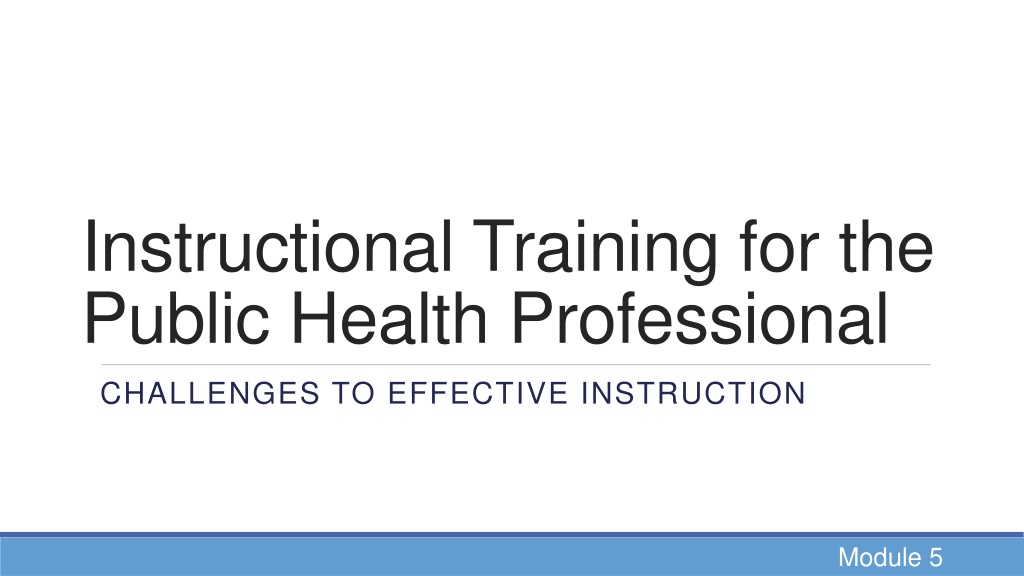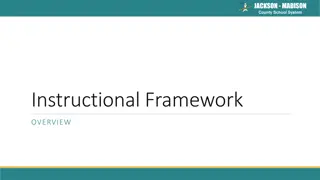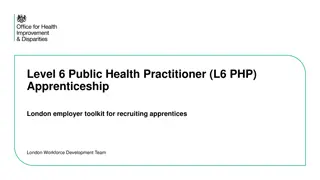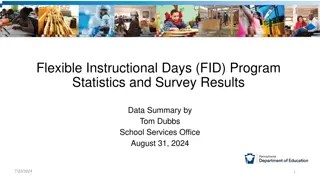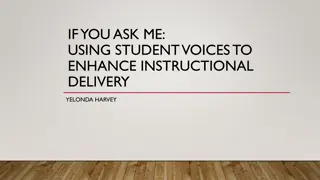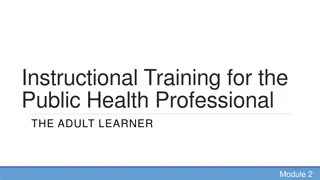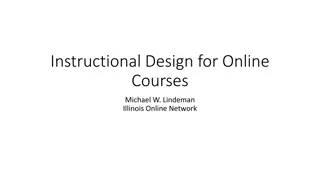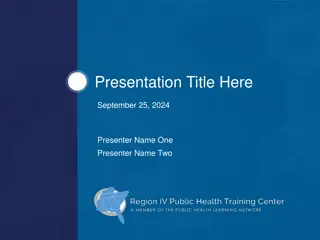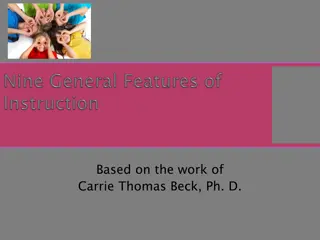Effective Instructional Training Strategies for Public Health Professionals
This instructional training module focuses on identifying challenges to effective instruction in public health settings and provides methods and tactics to overcome them. It covers topics such as recognizing physical challenges, arranging optimal learning environments, addressing participant/learner challenges, and utilizing various seating arrangements like theater style, classroom style, chevron style, cluster/pod style, and U-shape style. Additionally, time management tools for instructors are discussed to ensure efficient training delivery.
Download Presentation

Please find below an Image/Link to download the presentation.
The content on the website is provided AS IS for your information and personal use only. It may not be sold, licensed, or shared on other websites without obtaining consent from the author. Download presentation by click this link. If you encounter any issues during the download, it is possible that the publisher has removed the file from their server.
E N D
Presentation Transcript
Instructional Training for the Public Health Professional CHALLENGES TO EFFECTIVE INSTRUCTION Module 5
Module Objectives By the end of this module, participants will be able to identify challenges to effective instruction and determine methods and tactics to overcome them. Recognize physical challenges in the instructional setting Determine the best way to arrange a room for optimal learning Describe participant/learner challenges Determine methods to overcome challenges with the participant/learner 5-2 INSTRUCTIONAL TRAINING FOR THE PUBLIC HEALTH PROFESSIONAL
Comfortable Setting Temperature Lighting Seating and Table Arrangement Handicap Accessibility 5-3 INSTRUCTIONAL TRAINING FOR THE PUBLIC HEALTH PROFESSIONAL
Theater Style Suitable for Seminars and Lectures Shorter Presentations Not a setup for Notetaking Theatre Style Setup 5-4 INSTRUCTIONAL TRAINING FOR THE PUBLIC HEALTH PROFESSIONAL
Classroom Style Good for conducting traditional classroom activity Used for lecture and training Classroom Style Seating 5-5 INSTRUCTIONAL TRAINING FOR THE PUBLIC HEALTH PROFESSIONAL
Chevron Style Classroom Participants pointed toward instructor Effective style for lecture, training and instruction Chevron Style Seating 5-6 INSTRUCTIONAL TRAINING FOR THE PUBLIC HEALTH PROFESSIONAL
Cluster or Pod Style Participants pointed toward instructor Participants clustered in a U shape Effective for lecture, training and team building Cluster 5-7 INSTRUCTIONAL TRAINING FOR THE PUBLIC HEALTH PROFESSIONAL
U-Shape Style U is open to instructor/presenter Used for seminars, lecture, training and team building U-Shape Style Seating 5-8 INSTRUCTIONAL TRAINING FOR THE PUBLIC HEALTH PROFESSIONAL
Time Management Tools for the Instructor Practice the material to be presented Post a schedule for instruction Build in some extra time If you run late, make a new contract with participants Timekeeper 5-9 INSTRUCTIONAL TRAINING FOR THE PUBLIC HEALTH PROFESSIONAL
How do you address the participant that continues to ask questions and take up precious instruction time? How do you address the participant that is always showing up late from breaks? How would you address a participant that must miss two or three hours of a two-day training? How much time is appropriate to miss? Activity This is a whole class discussion that will identify some time management challenges and address some methods that may be used to overcome these challenges. Space is provide in your manual to record responses. 5-10 INSTRUCTIONAL TRAINING FOR THE PUBLIC HEALTH PROFESSIONAL
Inattentive Learner Behavior Sleeping Excessive Smart Phone Use Leaving Instructional Setting Side Conversations Characteristic Engage the participant with the relevance of the material Negotiate an agreement Intervention 5-11 INSTRUCTIONAL TRAINING FOR THE PUBLIC HEALTH PROFESSIONAL
Acting-Out Learner Behavior Outward Expression of Anger Taking Phone Calls in the Middle of Instruction Making Derogatory Statements Characteristic Don t take Actions that will Escalate the Situation Be Calm and Rational Move them out of the Instructional Setting Intervention 5-12 INSTRUCTIONAL TRAINING FOR THE PUBLIC HEALTH PROFESSIONAL
Summary Recognize physical challenges in the instructional setting Determine the best way to set a room for optimal learning Describe participant/learner challenges Determine methods to overcome challenges with the participant/learner 5-13 INSTRUCTIONAL TRAINING FOR THE PUBLIC HEALTH PROFESSIONAL
Coming Up Next Instructor Competencies 5-14 INSTRUCTIONAL TRAINING FOR THE PUBLIC HEALTH PROFESSIONAL
